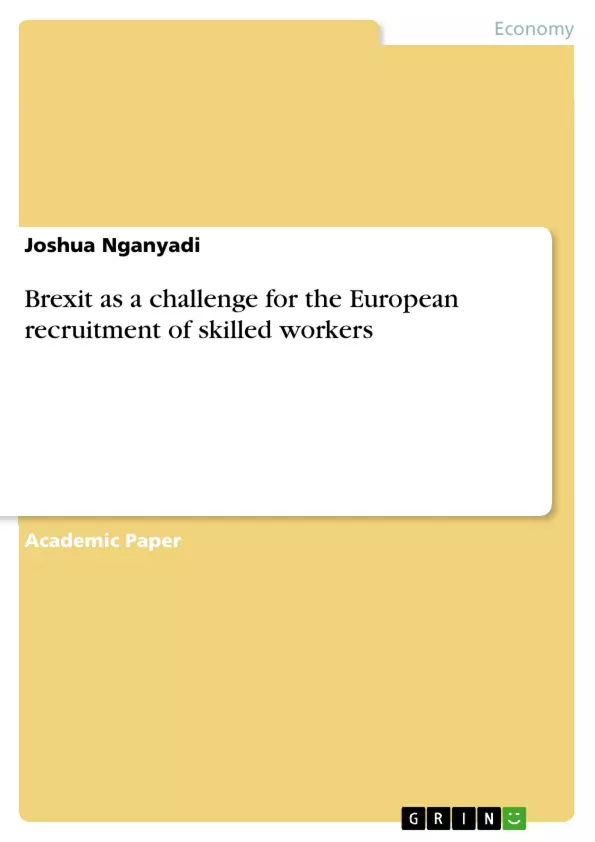This scientific work will deal with the opportunities and risks of abolishing the free movement of workers. The focus will be on forecasting the possible effects on European recruitment. Using an analogy between the United Kingdom and an EU member state (Germany), precise differences will be analysed and challenges from different aspects will be examined.
Brexit is currently a precedent case with already many political and economic implications. Accordingly, the research approach of this thesis is a literature analysis in combination with a scenario model. This is intended to present various exit scenarios of Great Britain vis-à-vis the EU and, in combination with an analysis of publications, to form recommendations for action for these scenarios.
On 23 June 2016, the inhabitants of the United Kingdom voted in a referendum by a majority of 51.9 to 48.1 percent in favour of their country leaving the European Union (EU). The decision to "British exit" (brexit) marks a turning point in the more than 40-year relationship between the United Kingdom and the European community of states. It is the first time that a member leaves the European family of states – a decision of primarily symbolic significance, which brings with it decades of constant enlargement and restriction of the EU's internal market.
In the campaign for EU withdrawal, the issue of "abolition of free movement of workers" and the associated immigration played a central role. It aims to reduce immigration and its dangers, such as "state loss of control and surveillance". From an EU perspective, every EU citizen loses the opportunity to take up and pursue work in the United Kingdom under the same conditions as citizens between EU states. From a UK perspective, the decision has a clear political objective, but it can have devastating consequences for the domestic economy.
Inhaltsverzeichnis (Table of Contents)
- 1 Problem definition
- 2 Theoretical background of brexite
- 2.1 Brexite as a challenge
- 2.2 United Kingdom
- 2.2.1 Economics
- 2.2.2 Multicultural society and immigration
- 2.3 European Union
- 2.3.1 Internal Market of the European Union
- 2.3.2 Free movement of workers
- 2.3.3 VWL Germany
- 2.4 Comparison of national economies
- 2.5 Impact to date
- 3. basics of classical recruitment
- 3.1 Classification of Recruitment in Human Resources Management
- 3.2 Principles and objectives of recruitment
- 3.3 Distinction between internal and external recruitment
- 4 Recruitment of skilled workers in the EU
- 4.1 European recruitment channels
- 4.1.1 Public employment services
- 4.1.2 Private Employment Agencies
- 4.1.3 Personnel leasing
- 4.1.4 Recruitment fairs
- 4.1.5 Online recruitment
- 4.1.6 Job advertisements in newspapers and magazines
- 4.1.7 University marketing
- 4.2 Shortage of skilled workers
- 4.3 Immigration
- 4.1 European recruitment channels
- 5 Forecast of European personnel recruitment after UK exit from the EU
- 5.1 Brexite vs. free movement of workers
- 5.1.1 Current situation
- 5.1.2 Restrictions on cross-border staff deployment
- 5.2 Scenario analysis - free movement of workers after Brexit
- 5.2.1 Scenario 1 - The 'Norwegen\" scenario
- 5.2.2 Scenario 2 - The 'Schweizer\" scenario
- 5.2.3 Scenario 3 - The 'Drittstaat\" scenario
- 5.2.4 Scenario 4 - The WTO option
- 5.2.5 Scenario 5 - Free trade agreements
- 5.3 Impact on labour migration
- 5.4 Skills shortages in the United Kingdom
- 5.5 Shortage of skilled workers in Germany
- 5.1 Brexite vs. free movement of workers
- 6 Impact on European recruitment
- 6.1 Recruitment in the United Kingdom
- 6.1.2 Opportunities and risks for British recruitment
- 6.2 Recruitment in Europe - Germany
- 6.2.1 Opportunities and risks for German recruitment
- 6.1 Recruitment in the United Kingdom
Zielsetzung und Themenschwerpunkte (Objectives and Key Themes)
This scientific paper explores the implications of Brexit on the European recruitment of skilled workers, particularly focusing on the challenges and opportunities for both the United Kingdom and Germany. The paper aims to provide a comprehensive analysis of the potential impact of Brexit on the free movement of workers, the recruitment landscape in both countries, and the future of European recruitment in the post-Brexit era. The key themes explored in the paper include:- The theoretical background of Brexit and its implications for the United Kingdom and the European Union.
- The impact of Brexit on the free movement of workers within Europe.
- The challenges and opportunities for recruitment of skilled workers in the UK and Germany.
- The various scenarios for future workforce mobility after Brexit.
- The potential impact of Brexit on European recruitment channels.
Zusammenfassung der Kapitel (Chapter Summaries)
Chapter 1 establishes the problem definition, setting the context for the subsequent analysis of Brexit's impact on European recruitment. Chapter 2 delves into the theoretical background of Brexit, examining its implications for the UK and the EU. It explores the economic, social, and political factors surrounding Brexit, particularly focusing on the free movement of workers and its potential disruption. Chapter 3 provides a comprehensive overview of the principles and practices of classical recruitment, laying the groundwork for the analysis of European recruitment practices. Chapter 4 focuses on the recruitment of skilled workers within the EU, including an examination of various European recruitment channels and the challenges posed by skilled worker shortages. Chapter 5 delves into the forecast of European personnel recruitment after the UK's exit from the EU. It explores different scenarios for workforce mobility and examines the potential impact on labour migration, skills shortages, and recruitment processes in both the UK and Germany. Chapter 6 investigates the specific impact of Brexit on European recruitment, analyzing the opportunities and risks for recruitment practices in both the UK and Germany.Schlüsselwörter (Keywords)
Brexit, European recruitment, skilled workers, free movement of workers, labour migration, skills shortages, recruitment channels, UK, Germany, workforce mobility, European Union.- Quote paper
- Joshua Nganyadi (Author), 2018, Brexit as a challenge for the European recruitment of skilled workers, Munich, GRIN Verlag, https://www.grin.com/document/703463



